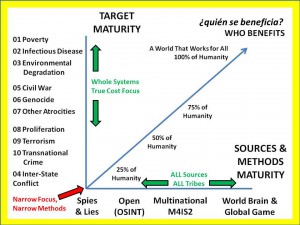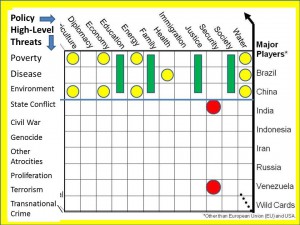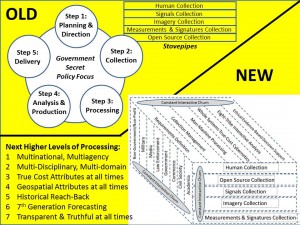Document (4 Pages): Healing the Americas with an Open Source Agency 2.0
En Espanol: 2013 Sanando a las Américas con una Agencia de Fuente Abierta
AAIntelligencia Marzo 2013: AAIMARZO2013

Healing the Americas with an Open Source Agency
Can Chile Lead the Americas Toward Open Source Everything?
Robert David STEELE Vivas, CEO, Earth Intelligence Network
Editor’s Note: The author spoke in Chile in November 2010, sponsored by the National Academy for Political and Strategic Studies (ANAPE), on the topic of “Impact of Globalization on Intelligence: Context & Challenge. His complete briefing, in video and in graphics, both in Spanish, is free online at http://tinyurl.com/SteeleCHILE. Here the author summarizes his presentation to the Inter-American Defense Board (IADB) in Washington, D.C. Now led by a Canadian general, the IADB will soon be led by Chilean General, Werther Araya Menghini. The original briefing in English can be seen at http://tinyurl.com/IADB-Abierto. An explanation of the logo and coat of arms can be found at http://tinyurl.com/OSE-LOGO.
In my view, the Organization of American States (OAS) is near death. Its possible replacement, the Comunidad de Estados Latinoamericanos y Caribeños (CELAC), is newly-born and has no voice just yet. The Inter-American Defense Board (IADB), independent of the OAS and now a subordinate part of the OAS, is in limbo, lacking vision, money, or merit. Only 26 of the 34 members of the OAS are also members of the IADB. The Inter-American Defense College (IADC), located in a single building near the US National Defense University at Fort Leslie J. McNair, is the one substantial element of the IADB, and is open to all members of the OAS, not only to those represented within the IADB.
I propose for consideration by Central and South America, and the Caribbean, three ideas:
01 The time has come for the OAS to die and CELAC to take its place. The USA has been guilty of virtual colonialism, unilateral militarism, and predatory capitalism against the South since its inception, and the South has been too slow to organize itself as a proper regional power able to resist. Just as the USA gave up the Panama Canal, so also should the USA – in my view – turn the OAS building over to CELAC, opening a new era in responsible relations between North and South within the Western Hemisphere. The substitution of CELAC for OAS will also enable the South to use CELAC for region to region treaties and agreements with Africa to the east and South Asia – especially Indonesia – to the west.
02 The IADB and the IADC, under the leadership of a Chilean general officer, could be used as a transition planning staff, with the next class at the IADC deliberately selected to move away from exclusively military participants and topics, and toward Whole of Government and a mix of political, economic, and technical topics as well as the traditional military topics. I believe that intelligence with integrity, not military force structure, will be the defining power of the 21st Century. This is the theme of my next book, with the objective of facilitating hybrid governance, using open sources to provide decision support that is multinational and multiagency in nature.
03 An Open Source Agency (OSA), collaboratively funded, staffed, and supported by all of the CELAC member states, would immediately empower the South against the excessive influence of the North, an influence that is too often based on a mix of ignorance and arrogance and the part of the North, and inadequate intelligence (decision-support) available to and shared among leaders of the South.

What Is an Open Source Agency (OSA)?
An Open Source Agency (OSA) is an intelligence-gathering and decision-support capability that relies exclusively on sources and methods that are open, in all languages (183). It offers five opportunities for each participating nation-state:
01. It can serve as the national Open Source Intelligence (OSINT) hub, assisting the eight “tribes” of intelligence in each country (academic, civil society including labor unions and religions, commerce, government at all levels, law enforcement, media, military, and non-governmental/non-profit) to access and exploit any information in any language that can be obtained legally and ethically. 80% of that information will not be available online – OSINT is above all a Human Intelligence (HUMINT) practice. The global human networks of each tribe are a national resource that is not now properly exploited, in my opinion.
02 It can host a Global Planning and Monitoring Centre (GPMC) as a service of common concern for all of the participating nation-states. In this fashion the ten high-level threats to humanity identified by the UN High-Level Panel on Threats, Challenges, and Change, can be monitored very professionally on behalf of the region, with each nation-state receiving the same basic services upon which it is free to build its own collection plans and appraisals. Those threats are, in this priority order:
| PovertyInfectious DiseaseEnvironmental DegradationInter-State Conflict
Civil War |
GenocideOther Atrocities (e.g. Trade in Children)Proliferation (including Small Arms)Terrorism (including state-sponsored)
Transnational Crime (including Wall Street) |
03 It can host a Multinational Decision-Support Centre (MDSC), one that can be used as a regional intelligence and operations centre for orchestrating regional evaluations of specific threats and opportunities, such as Genetically Modified Organisms (GMO) that I myself consider an irresponsible crime against humanity.
04 It can support each individual nation-state in their becoming a Smart Nation, with a fully integrated national network of free education for all (inclusive of graduate education and continuing education for all adults); pervasive and persistent intelligence (decision-support) for every element of each of the eight tribes; and integrated multi-disciplinary research able to achieve new levels of regional collaboration, cost-savings, and market offerings.
05 It can serve as a service of common concern helping each nation-state migrate away from proprietary software and hardware – many over-priced and under-performing, and none of them scalable to national and regional needs – and toward an “all in” approach to Open Source Everything (OSE). Below are listed twenty-four examples, there are many more.
| Open AccessOpen ArchitectureOpenBTSOpen Cloud
Open Cost Open Courseware Open Data Open Design |
Open EcologiesOpen EducationOpen GeospatialOpen Government
Open Hardware Open Knowledge Open Manufacturing Open Materials |
Open MoneyOpen ScienceOpen SecurityOpen Space
Open Society Open Software Open Spectrum Open Standards |
I expect many traditional leaders, and especially military leaders, to object. Generally people object to anything that is new, that they do not understand, and that they mistakenly believes threatens their hard-earned positions and privileges. I therefore pause to observe that Admiral James G. Stavrides, USN, Supreme Allied Commander Europe (SACEUR), has spoken before a TED audience to call for “Open Source Security.”

He asks us to imagine global security driven by collaboration – among agencies, government, the private sector, and the public. He suggests that dialog and openness will be game-changes, and states that we must build bridges – that sharing information is how we connect everything.
For close to a decade now I have been pursuing, in addition to Open Source Everything (OSE), the Swedish military concept, enhanced, of Multinational, Multiagency, Multidisciplinary, Multidomain Information-Sharing (M4IS2). Generally open, but certainly also possible in a secret manner, M4IS2 helps nation-states avoid duplicate costs and avoid gaps in their understanding. By emphasizing multi-lingual and multi-cultural information-sharing and sense-making – this is far removed from the North American insistence on unilateral and bi-lateral secrets to the exclusion of all open knowledge – each participant is empowered by access to a broader and deeper range of sources and methods, and I can absolutely assure one and all that this will yield a substantially superior understanding of all relevant information, than can be brought to bear by secret methods alone.
I was a military officer for many years, and have served in the national security environment for over 35 years. I am intimately familiar with how much we spend on war and the tools of war, and I am intimately familiar with how many national political leaders abuse their military budgets and military powers. My observation is not directed so much at what the South itself spends, but rather at what the South allows the US to spend on military and law enforcement. The degree to which the USA is now waging war on sub-national groups within countries that it is not at war with, is in my view destabilizing, unethical, inappropriate, and something that should be stopped as soon as the region can agree on both the threat that this represents, and a plan to reverse this threat. For one third of what the USA spends on war I could give every person on the planet a free cell phone for life, a small house with electricity and clean water, and a free education, the latter in turn creating infinite wealth from human innovation.

At the same time, governments have failed to mature in the digital era, and are not understanding the true costs of well-intentioned but ignorantly-formed policies, most developed in isolation from any strategic analytic model and also in isolation from one another – agricultural policy ignores national water scarcity issues, energy ignores the urgent need to achieve solar power solutions for desalinating water in massive quantities, and so on. Perhaps most dangerously, most countries are not fully aware of the great danger represented by USA pharmaceuticals and USA-designed vaccines some of which now contain both infertility toxins, and the herpes virus. Here to the side is a strategic analytic model that can be used to better review national and regional sources and methods as well as to harmonize national and regional policies as well as extra-national donations and investments. The USA is focusing on the two red dots. Ignorant about all else.

In my view, all eight of the intelligence tribes, but especially the academic, commerce, and government tribes, must rise to a new standard of decision-support practice. The traditional practice of focusing on one problem, one source, one method, one customer, is not adequate to the complexities of the modern world. We much achieve a new more sophisticated national intelligence posture that connects all minds with all information in all languages all the time, and is in a state of constant churn. Here to the side I illustrate the old process and the new process as I would implement it if any country desired to do this, as well as in any region that decides to collaborate in this manner.
I will end on a note of great optimism. The era of empire is over. While the Chinese empire is just beginning to grow – Argentina is expected to be majority Chinese by 2025 – they are using soft power instead of hard power, and generally not telling as many lies as the USA has been getting away with because of its corruption of the elites from country to country. The time has come for each country – and for the region – to evaluate the importance of public hybrid governance – the government cannot govern by itself – the role that education, intelligence, and research play in creating a powerful prosperous nation – and the value to be gained by creating a regional Open Source Agency (OSA). For my part, I would be very glad to be invited to serve the South, where my mother was born. I desire prosperity and peace for the South, and believe that these ideas can advance the public interest in a very positive direction. St.



